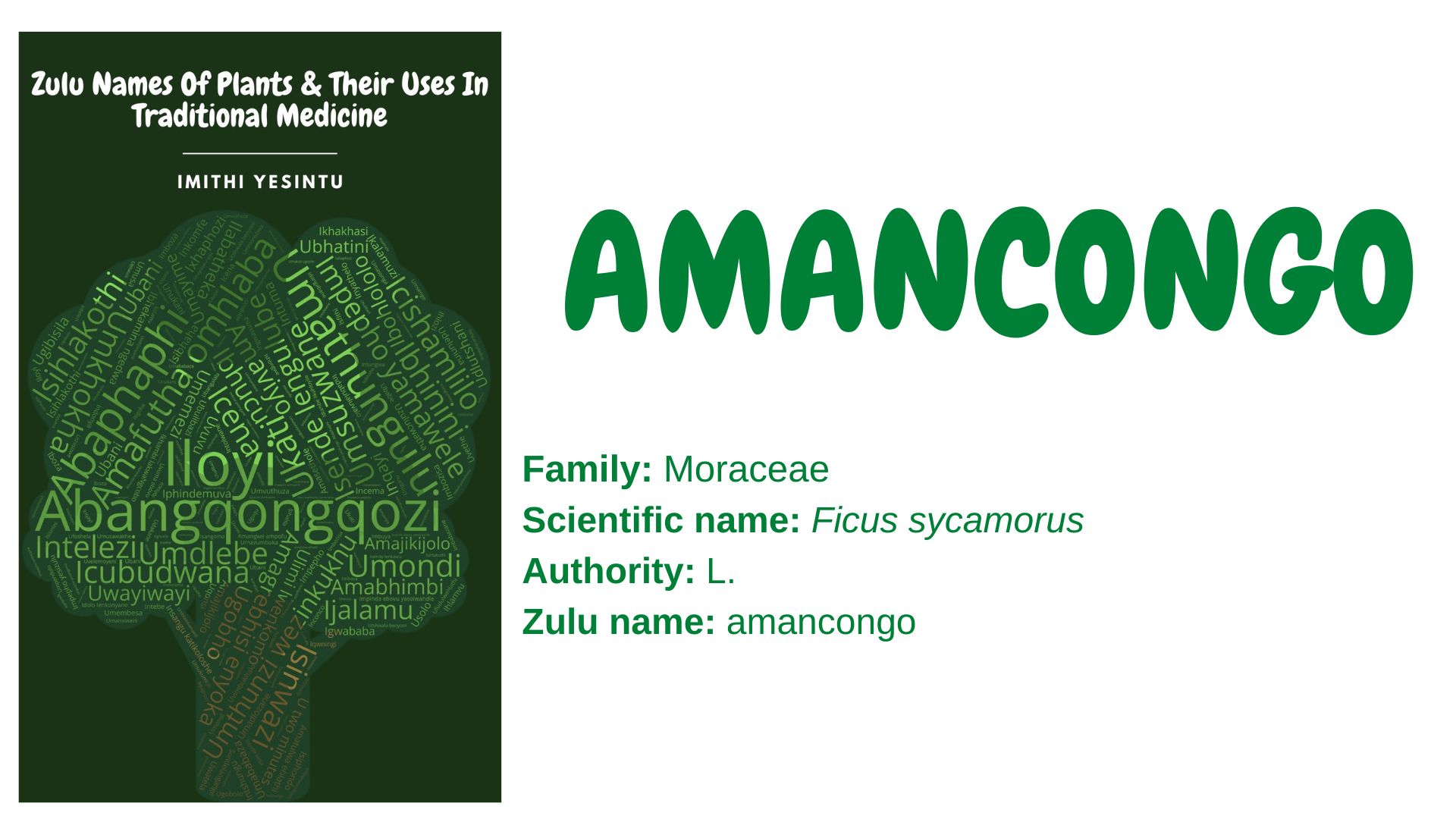Family: Moraceae
Scientific name: Ficus sycamorus
Authority: L.
Synonyms: Ficus chanas Forssk., Ficus cocculifolia Baker, Ficus comorensis Warb., Ficus damarensis Engl., Ficus integrifolia Sim., Ficus scabra Sim.
Zulu name: amancongo
Other names: bush fig, strangler fig, sycamore fig, fig mulberry
Plant description: F. sycamorus is a medium-sized to large tree with heart-shaped dark green leaves, edible round fruits that turn yellow or red when ripe and a green or yellow bark with white latex. The plant occurs naturally in the South African woodland habitat near streams.
Uses:
- The white latex is applied topically on burns, inflammation, ulcers, and warts. It promotes healing.
- The bark is boiled and the decoction is used to treat respiratory infections, such as sore throat, chest infection, and scrofula.
- The bark is used to make decoctions to treat infertility, low sperm count, and sterility.
- Eating leaves and fruits stimulates lactation. It increases breast milk production.
- The fruits are used to prepare alcoholic beverages.
- The leaves are mixed with ground nut cakes and eaten as food.
- The wood ash is used as an alternative to salt.
- The bark is soaked in water and the infusion is used to treat insomnia.
- The bark infusion is used to treat pain.
- The bark infusion is used to treat epilepsy.
- The bark is used to treat diabetes mellitus.
- The bark decoction is used to treat excessive menstrual flow.
- The leaves are used to treat jaundice.
- The roots are used as a laxative.
- The seeds help prevent constipation.
- The plant is used to treat diarrhoea.
- The leaves are used as an antidote for snakebite poison.
- The milk latex and bark is used as anthelmintic, against ringworms.
- It is cultivated as an ornamental shade plant.
Safety precaution:
Using traditional medicine responsibly can enhance your overall health and well-being. Misuse and abuse can lead to complications. You can inquire about the correct use of traditional medicine from a knowledgeable herbalist and practitioner. You can also visit imithiyesintu.co.za or email: info@imithiyesintu.co.za to learn more about traditional medicine
References and further reading:
- Al-Matani, S.K., Al-Wahaibi, R.N. and Hossain, M., 2015. Total flavonoids content and antimicrobial activity of crude extract from leaves of Ficus sycomorus native to Sultanate of Oman. Karbala Int J Mod Sci 1(3), pp.166–71.
- Bello, O.M., Ojediran, O.J., Dada, A.O., Olatunya, A.M. and Awakan, O.J., 2015. In Vivo Toxicity Studies and Phytochemical Screening of Stem Bark of Ficus Sycomorus Linn (Moraceae). IOSR J Environ Sci Ver I 9(3): pp.2319–99.
- Erhirhie, E.O., Ilodigwe, E.E. and Ihekwereme, C.P., 2018. Ficus Sycomorus L (Moraceae): A review on its Phytopharmacology and toxicity profile. Discovery Phytomedicine, 5(4), pp.64-71.
- Ibrahim, G., Abdulmumin, S., Musa, K.Y, and Yaro, A.H., 2008. Anticulvusant Activities of Crude Flavonoid Fraction on the Stem Bark of Ficus sycomorus (Moraceae). J Pharmacol Toxicol 3(5):pp. 351–6.
- Kassa, A., Tadele, Y. and Mekasha, Y., 2015. Ficus sycomorus (Sycamore Fig or Shola) Leaf, A Potential Source of Protein for Ruminants: A Review. J Fish Livest Prod [Internet] 3(4):pp.1–9.
- Maundu, P, and Tengnas, T., 2005. Useful trees and shrubs for Kenya. World Agroforestry Centre.
- Mudi, S.Y, Muhammad, A., Musa, J. and Datti, Y., 2015. Phytochemical Screening and Antimicrobial Activity of Leaves and Fruits Extract of Ficus sycomorus. Chem Search J. 6(1).
- Njagi, J., Piero, M., Ngeranwa, J., Njagi, E., Kibiti, C. and Njue, W., 2012. Assessment of Antidiabetic Potential of Ficus Sycomorus on Alloxan-induced Diabetic Mice. Int J Diabetes Res. 1(4): pp.47–51.
- Offiah, N.V., Makama, S., Elisha, I.L., Makoshi, M.S., Gotep, J.G. and Dawurung, C.J., 2011.. Ethnobotanical survey of medicinal plants used in the treatment of animal diarrhoea in Plateau State , BMC Vet Res.
- Okpara, J.O., Ochai, C.Z., Shwarpshakka, S.Y., Kaigoma, G.J, and Salihu, A.A., 2017. Phytochemical and Antibacterial Activities of Ficus Sycomorus (Linneaus) leaves and unripe fruits extracts. Int J Sci Appl Res 2(2):pp. 43–56.
- Samia, M., Makboul, A., Rofia, M. and Salwa, F.F., 2016. Hypotensive effect of Ficus sycomorusL. on the arterial blood pressure of rabbits. Res Rev J Pharmacogn Phytochem 4(2): pp.1–6.
- Wakil, A.M, Sandabe, U.K., Mbaya, A.W., Ngulde, S.I., Sodipo, O.A, and Shettima, M.S., 2016. Evaluation of Trypanocidal efficacy of Aqueous extract of Ficus sycomorus Linn. (Moraceae) stem bark in Albino rats. Vom J Vet Sci11:pp. 58–72.
You Can Order Your Copy Of The Book By Emailing: info@imithiyesintu.co.za
Feel Free To Add Other Uses Of This Plant In The Comment Section Below:
